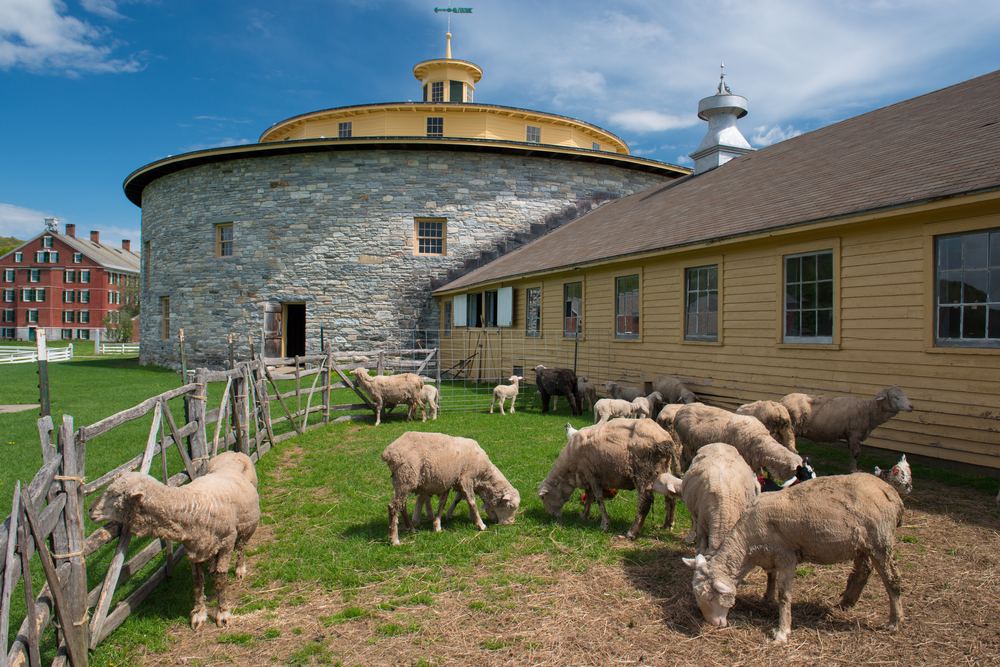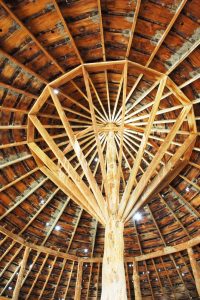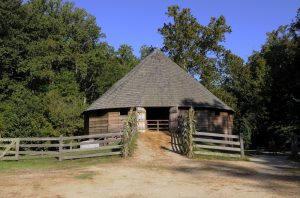
Round Stone Barn in Hancock Shaker Village, MD
When you picture a barn, you likely envision the traditional red banker barn, with four sides and a gable roof. The first image to pop into your mind probably isn’t a round barn, but these were once an immensely popular design. Thought to be more efficient than standard barns, as well as offer protection from the devil (he couldn’t trap you in a corner, duh), round barns were seen as revolutionary structures. George Washington had one, so you know it was cool.
 The first modern round barn in the U.S. was built in 1826 in Hancock Shaker Village, MA. It was made up of four “rings.” The innermost ring was used for ventilation, the second out was where hay was stored, and the third was where the farmers would walk to distribute hay to the cows, who were kept in the fourth. Every four feet around the outermost ring were trap doors, which were used to quickly scoop manure into a pit below. Farmers and other workers would access the pit and transport the manure to their fields and gardens to be used as fertilizer.
The first modern round barn in the U.S. was built in 1826 in Hancock Shaker Village, MA. It was made up of four “rings.” The innermost ring was used for ventilation, the second out was where hay was stored, and the third was where the farmers would walk to distribute hay to the cows, who were kept in the fourth. Every four feet around the outermost ring were trap doors, which were used to quickly scoop manure into a pit below. Farmers and other workers would access the pit and transport the manure to their fields and gardens to be used as fertilizer.
Round barns were most popular between 1880 and 1920, part of an Industrial Era obsession with efficiency. Because of their shape, they required less materials and were cheaper to construct than other types of barns. The circular interior layout meant that farmers could work in a continuous direction, and wagons could enter without having to back out.
Round barns are especially common in the Midwest. The College of Agriculture at the University of Illinois played an important role in the promotion and spread of the design. After the three round barns on its campus were built in early 1900s, countless farmers were inspired to follow suit. “It is obvious that the advantages of the round barn are convenience, strength, and cheapness,” wrote Professor Wilbur J. Fraser of the University’s Agricultural Experiment Station.
There are two types of round barns: polygonal and “true circular.” True circular round barns are generally considered more masterly, as the construction of fully round sides takes a certain amount of architectural skill. Before the 1900s, most round barns were polygonal; after, almost all were true circulars.
 The round barn at Mt. Vernon was built with sixteen sides, an unusually high number even for polygonal barns. The barn was designed by George Washington himself and built with the help of his carpenter. It served as a building for grain processing and storage, which at the time was done by treading. A round barn provided space for horses to tread in a circular motion, something Washington expected to improve the efficiency of the process. “The result was a building that was conceptually as much a machine as it was architecture,” writes Dennis J. Pogue of the University of Maryland.
The round barn at Mt. Vernon was built with sixteen sides, an unusually high number even for polygonal barns. The barn was designed by George Washington himself and built with the help of his carpenter. It served as a building for grain processing and storage, which at the time was done by treading. A round barn provided space for horses to tread in a circular motion, something Washington expected to improve the efficiency of the process. “The result was a building that was conceptually as much a machine as it was architecture,” writes Dennis J. Pogue of the University of Maryland.
Most impressive is that Washington conceived of this design in 1792, almost one hundred years before round barns became popular. Forget founding father of the country; ol’ George was the founding father of round barns.
Eventually, widespread mechanization reduced the supposed advantages of round barns, and the style died out almost as quickly as it came into fashion. By the 1930s, very few new round barns were being constructed.
Nonetheless, they are architectural marvels, and most original round barns in the United States have a spot on the National Historic Register. Pennsylvania is lucky enough to have a handful of these landmarks. If you ever find yourself near State College, the Neff Round Barn in Centre Hall, PA is just a short drive away (and highly Instagrammable — it’s central PA’s most-photographed barn).
Close to Gettysburg is the Historic Round Barn and Farm Market, part of a working farm. Built in 1914, the barn now houses a market which is open from April to November, and offers fresh fruits, veggies, baked goods, and gifts.
Speaking of, the Gettysburg Museum and Visitor Center is a much more recent example of a round barn. Built in 2008, it’s twelve-sided and bright red, a fitting nod to the round barn era. If you look for them, modern takes on traditional round barns are all around us, from backyard sheds to bank buildings.
Other historic round barns are scattered across the rural U.S., and if you ever happen to pass one on a drive, it’s worth stopping to take a look. They represent a unique period in American farming, with impressive architectural design. If nothing else, get out of your car, walk in, and enjoy some safety from the devil.